This is a free fortnightly newsletter about the New Zealand Net. If you would like to be notified by email when a new edition is published, please contact ZL1NZ.
Browse our Newsletter Archive and List of Net Tips.
Featured key
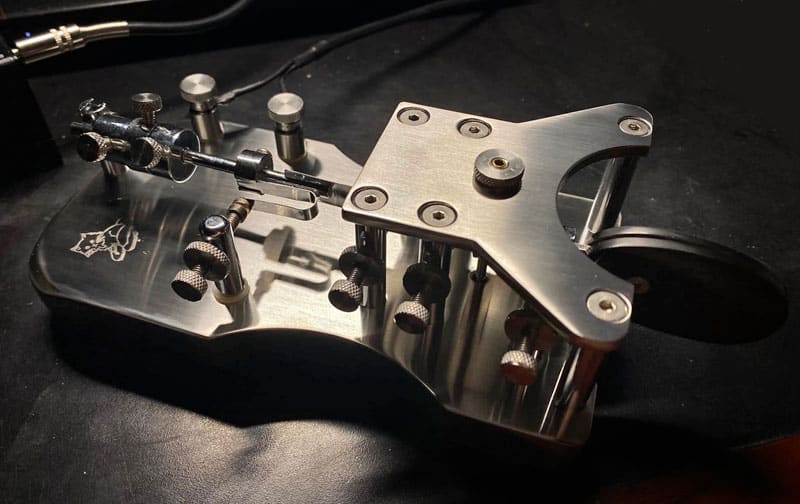
This semiautomatic key from China is called a Slipper. It is manufactured from stainless steel and chromed brass. Unfortunately, I have no more information about it. Photo: Ju Tang in Facebook group CW Bugs, Keys and Paddles
* If you have an interesting key for this feature, please send me a nice clear photo and a few words describing it.
Quick notes
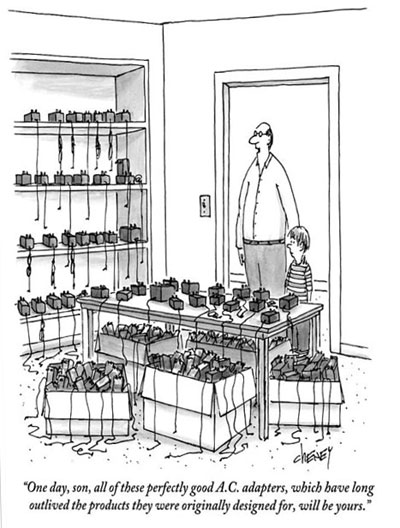 This cartoon reminds me of when I lived in Toronto a few years ago. In the basement of our apartment building was an electronics recycling bin from which I salvaged many perfectly usable or repairable items. I ended up with heaps of ‘wall-wart’ power supplies, which I would test and label, showing the voltage and power rating in text that was actually large enough to read. At our radio club meetings I would put several on the table and the winner of that night’s door prize could choose one to take home. I still collect these things and am continually finding uses for them. How about you?
This cartoon reminds me of when I lived in Toronto a few years ago. In the basement of our apartment building was an electronics recycling bin from which I salvaged many perfectly usable or repairable items. I ended up with heaps of ‘wall-wart’ power supplies, which I would test and label, showing the voltage and power rating in text that was actually large enough to read. At our radio club meetings I would put several on the table and the winner of that night’s door prize could choose one to take home. I still collect these things and am continually finding uses for them. How about you?
The CWB Net has been relaunched as a weekly net, and eight New Zealand stations checked in to the first weekly session on 23 March. The net begins at 0603Z each Wednesday on 14349 kHz. Net manager is Roy VK6RR.
New Zealand reverts to standard time at 0300 hours Sunday 3 April. The NZ Net will continue at 2100 hours local time, which will be 0900Z rather than 0800Z. I am interested in hearing how the change affects signals at your location, so drop me a line or radiogram.
Photo flashback
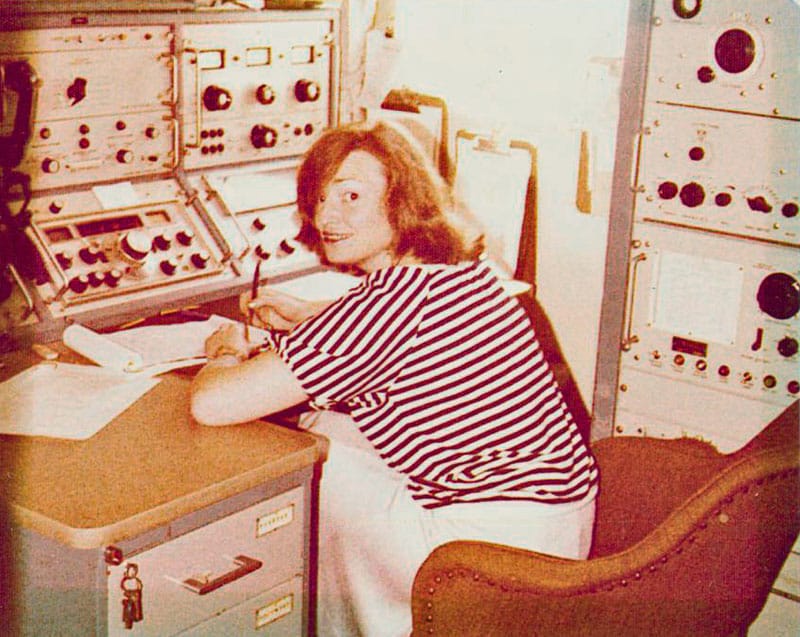
Radio Officer Phillippa (Pip) Were aboard Coastal Trader ZMSF in 1977. Photo: P Were
Phillippa (Pip) Were (nee Reynolds) joined the ro-ro freighter Coastal Trader in 1974, the year after the ship was purchased by the New Zealand Shipping Corporation. Pip was the second woman to work as a ship’s radio officer in New Zealand, and you can read her impressive story here.
Net numbers
March was a busy month on NZ Net, with a couple of new stations being welcomed to the Net: Kimberly ZL4KJ and Graeme ZL2TE.
We also set a new record for traffic, with 92 messages handled. And of course we had our third anniversary on 25 March, although we didn’t manage to break the record for stations in a single session (14).

Here is the monthly report, as transmitted to all stations during the NZ Net on 1 April.
NR12 R ZL1NZ 45/42 AUCKLAND 0800Z 1APR22 = NZ NET = MAR QNI VK3DRQ 23 VK4PN 8 ZL1AJY 1 ZL1ANY 20 ZL1AYN 1 ZL1BWG 21 ZL1NZ 23 ZL2GD 15 ZL2GVA 22 ZL2KE 14 ZL2LN 6 ZL2TE 1 ZL3RIK 1 ZL3TK 23 ZL4CU 10 ZL4FZ 7 ZL4KJ 12 ZL4KX 11 TOTAL 219 QTC 92 = ZL1NZ
Tips & tools: Key jacks

This key is plug ‘n’ play. No need to fiddle with screw terminals. Photo: ZL1NZ
I have a few keys and I prefer to keep those not currently in use on shelves where I can admire them. But having them cluttered up with cords and plugs really spoils their appearance and presents needless duplication.
So, I am gradually fitting each key with an RCA jack. My lightweight keys, such as the one pictured, are already mounted on acrylic bases for stability, so that’s where I put the connector. For larger keys, the aluminium bracket holding the RCA jack could be mounted simply on the earth terminal of the key or bug.
This also makes it easy to quickly change keys in mid QSO if, for example the contacts are overheating from too much ragchewing. (I am joking.)
Got a tip or tool to make CW operating more fun? Please send me a photo and a few words.
Seriously, don’t leave this all to me or I can guarantee the ideas will get worse with each edition!
Audio challenge
Here’s a real easy one. What net is this and who is the Net Control Station? Send your answer via radiogram (or email if no propagation) to ZL1NZ.
Answer to previous Audio Challenge:
You were asked to identify the aeronautical beacons heard in a recording. There were fifteen beacons that I would consider readable, and each callsign was sent twice. They were, in order of appearance:
AP, KT, PP, WE, HK, WR, TG, NL, MI*, WK, TU, SF, HL, WU, LX
* The beacon heard on the same frequency as NL (358 kHz) was copied by some, including me, as UI. The only beacon list I have been able to find (it is unofficial) does not list UI but it does list MI on 358 kHz. So, well done those who copied it correctly. I have listened to this recording many times and I still hear UI! My subsequent attempts to tune in the mystery signal have not been successful.
Calling all cryptographers
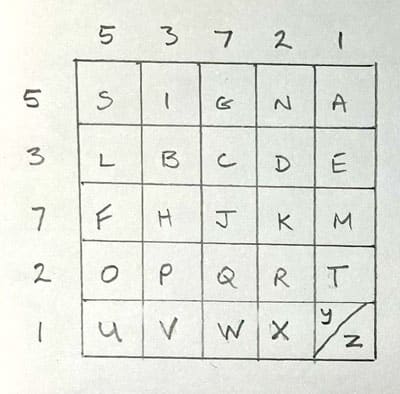 The Radio Security Service Memorial Amateur Radio Society is inviting all amateurs to copy an encrypted message (5-number groups) which will be transmitted on Tuesday 5 April 2022 at 1300Z, 1500Z, 1800Z and 2100Z from the club’s station GI5TKA. Frequencies will be 14,028 and 7028 kHz, possibly supplemented in the last session by 3528 kHz.
The Radio Security Service Memorial Amateur Radio Society is inviting all amateurs to copy an encrypted message (5-number groups) which will be transmitted on Tuesday 5 April 2022 at 1300Z, 1500Z, 1800Z and 2100Z from the club’s station GI5TKA. Frequencies will be 14,028 and 7028 kHz, possibly supplemented in the last session by 3528 kHz.
Roger MI0WWB says: “This radio activity day will be a bit different from our previous radio activity days, when we used a simple letter shift as a cypher key. This time we will use a double encrypted code. For this we will need a code word and a 5-digit code number to decrypt the message.
“We shall use the code word ‘signal’ and the code number ‘53721’.”
For more information, including instructions on using the decoder grid, visit the GI5TKA webpage.
Video: US Merchant Marine radio operators (2011)
Produced by Mark Haskell WB9UJS, Edited by Bernard Huth W4BGH
Net tip: Originating 3rd party messages
Richard ZL4FZ asked me whether NZ Net would handle 3rd party traffic. The answer is ‘Yes’ so let’s take a look at how it’s done, starting from the very beginning:
What is 3rd party traffic? It’s traffic sent from one amateur to another amateur, where the message is from or to a third party who (in most cases) is not a radio amateur.
We’ll consider only domestic 3rd party traffic for the moment, as international traffic requires ‘third party agreements’ between countries. Within New Zealand, however, there is only one restriction on third party traffic: a radio amateur cannot be paid for the service. So we have heaps of latitude to provide this service.
Why do 3rd party traffic? Back the Good Old Days (hereinafter referred to as tGOD) before the internet, cellphones and cheap long-distance phone calls, third party traffic was a significant part of amateur radio activity, in the USA and Canada at least. It took two main forms: radiograms (almost always via CW) or phone patches using SSB. And it was usually done to save the cost of a phone call. Sometimes it was designed to promote ham radio, such as the popular radiogram booths at state fairs in the USA where a visitor could send a message to their friends or family far away. The ARL numbered messages got lots of use at these events, especially number FIFTY ONE. 🙂
Nowadays, we have little need of third party traffic, but it’s still a nice bit of homage to tGOD, and provides a memorable experience for our third party ‘customers’, rather like getting a telegram from the Queen on one’s 100th birthday.
Since telegrams and radiograms are much less common than in tGOD, I suggest that we only send 3rd party messages when we are reasonably confident the recipient will not be confused or distressed as a result.
How do I send a 3rd party radiogram? Just put the name and contact details of the recipient in the address field of your radiogram form, like this:
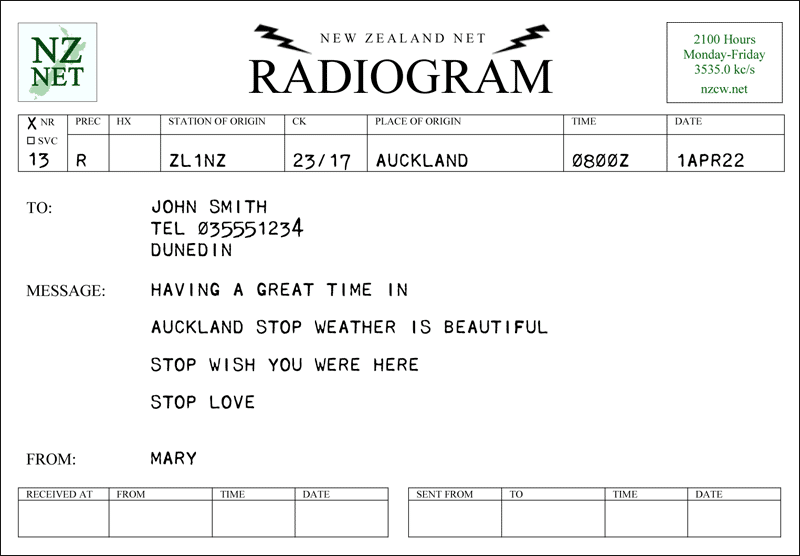
Please include the city/town of the recipient but do NOT address your 3rd party traffic to an amateur station. Net Control will determine the appropriate message routing, which I’ll look at in the next NZ Net News. In part 3, I’ll talk about how to deliver a 3rd party message.
Advertising archive
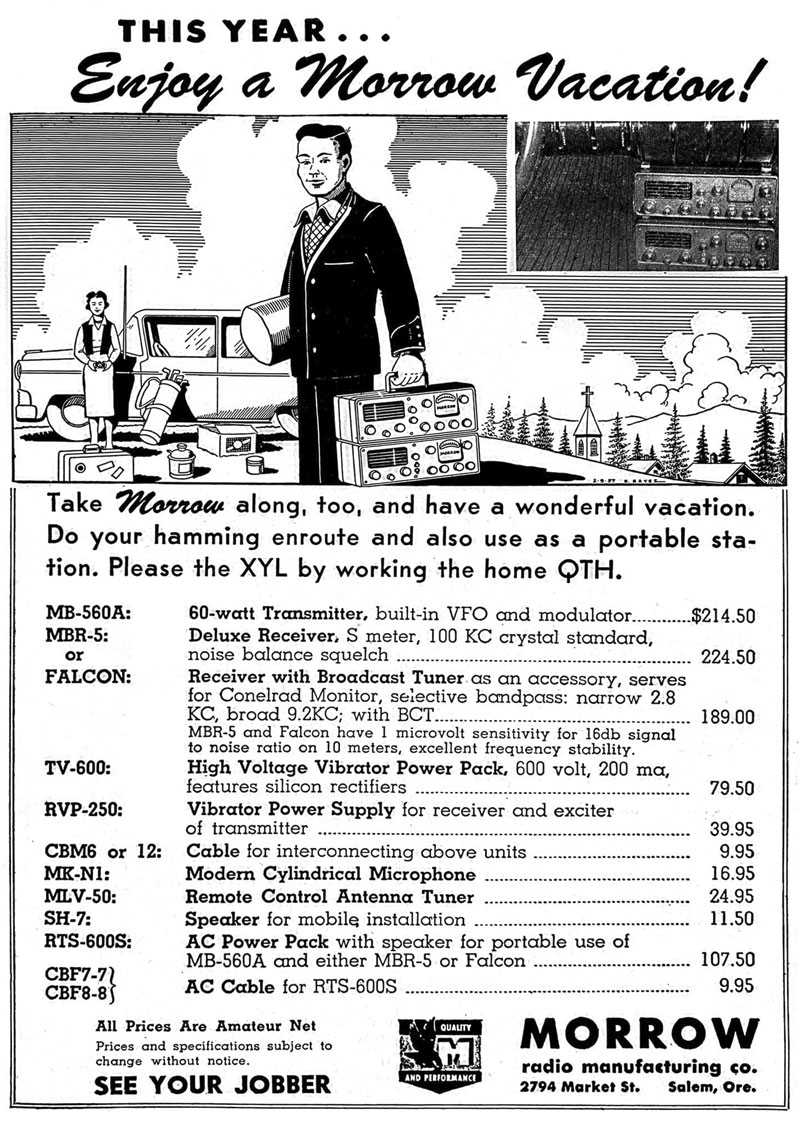
“Say honey, did you remember to pack your ham radio for our vacation?” Said by no one, ever.
Suggestions?
If you have suggestions on how to make the NZ Net better, or things you’d like to see covered in these updates, please contact ZL1NZ. You might even like to write something for the newsletter.
Thanks for reading, and I hope to hear you soon on the NZ Net!
—
Neil Sanderson ZL1NZ, Net Manager
New Zealand Net (NZ NET)
3535.0 kHz at 9pm NZT Mon-Fri



